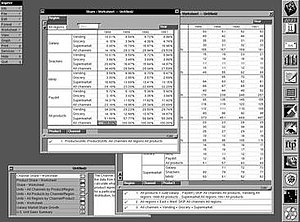Lotus Improv

Lotus Improv running on NeXTSTEP showing Improv's interface to multidimensional data
|
|
| Developer(s) | Lotus Development |
|---|---|
| Initial release | 1991 |
| Operating system | NeXTSTEP, Windows 3.1 |
| Type | spreadsheet |
| Website | www-01 |
Lotus Improv is a discontinued spreadsheet program from Lotus Development released in 1991 for the NeXTSTEP platform and then for Windows 3.1 in 1993. Development was put on hiatus in 1994 after slow sales on the Windows platform, and officially ended in April 1996 after Lotus was purchased by IBM.
Improv was an attempt to redefine the way a spreadsheet program should work, to make it easier to build new spreadsheets and to modify existing ones. Conventional spreadsheets used on-screen cells to store all data, formulas, and notes. Improv separated these concepts and used the cells only for input and output data. Formulas, macros and other objects existed outside the cells, to simplify editing and reduce errors. Improv used named ranges for all formulas, as opposed to cell addresses.
Although not a commercial success in comparison to mainstream products like Lotus 1-2-3 or Microsoft Excel, Improv found a strong following in certain niche markets, notably financial modeling. It was very influential within these special markets, and spawned a number of clones on different platforms, notably Lighthouse Design's Quantrix, which has since been spun off into its own company.
Apple Inc.'s Numbers combines a formula and naming system similar to Improv's, but running within a conventional spreadsheet.
The original spreadsheets were pieces of paper with vertical and horizontal lines on them, a customized worksheet intended for accounting uses. Users would enter data into rectangular areas on the sheets, known as cells, then apply formulas to the data to produce output values that were written down in other cells. A Berkeley professor, Richard Mattessich, was a proponent of using spreadsheets for financial modeling and "what if" calculations for businesses, but noted that it could take so long to recalculate it to run a different scenario that the inputs would be out of date by the time the calculation was finished. In 1964 he proposed using a computer to run all of the calculations from the point of the change on, thereby updating the sheet in seconds, rather than days.
...
Wikipedia
